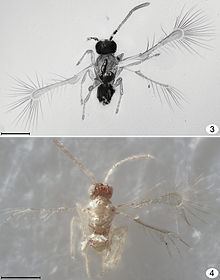Kingdom Animalia Order Hymenopteraa Species T. nana Higher classification Fairyfly | Phylum Arthropoda Family Mymaridae Scientific name Tinkerbella Rank Genus | |
 | ||
Similar Fairyfly, Spiculosiphon oceana, Cape Melville leaf‑tailed, Edwardsiella andrillae, Liropus minusculus | ||
Tinkerbella is a genus of fairy wasps, containing the single species T. nana from Costa Rica. It is one of the smallest known flying arthropods and belongs to the family Mymaridae. The smallest flying arthropod known is Megaphragma caribea, a trichogrammatid wasp that measures 170 micrometres long.[1]
Contents
History
It was identified by a team led by John Huber at the Canadian National Collection of Insects and John Noyes at the Natural History Museum. Noyes collected it during a scientific expedition in the tropical forests of Costa Rica. Tinkerbella specimens have been added to the museum collection of about 1.5 million wasps, which are used by researchers worldwide. The scientific description of Tinkerbella nana was published in the Journal of Hymenoptera Research. It was named after the fairy Tinker Bell in the 1904 play Peter and Wendy (a.k.a. Peter Pan) by J.M. Barrie.
Specimens were collected in Costa Rica by Noyes using a heavy triangular sweep net fitted with a galvanized metal screen with 4 mm mesh over the opening. Sweeping was done by gently dragging the net through vegetation and dumping the net contents at five-minute intervals into 80% ethanol in a sturdy polythene bag to reduce damage to insects in the debris. Sweeping was done for two hours periods (barring rain) so different samples could be compared, if necessary. The samples were sorted later in a laboratory using the method described here to ensure that all the smallest Hymenoptera were found.
Appearance
Tinkerbella nana is 250 micrometres (0.0098 inches) long, equivalent to 2.5 times the width of a human hair.
